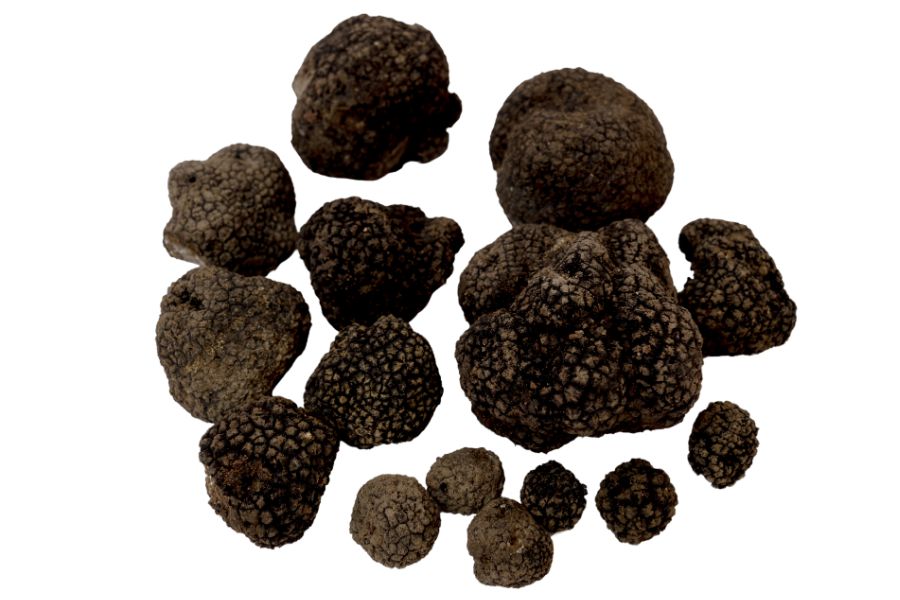Hunting wild truffles in Kansas takes patience, timing, and a bit of luck. These underground fungi are hard to spot and even harder to collect, but their rarity and culinary appeal keep foragers searching.
Most people don’t realize truffles grow beneath the oak-lined hills, sandy woodlands, and cedar breaks that dot the state. Unlike surface mushrooms, you’re searching for something hidden, which makes the discovery feel even more rewarding.
It’s not unusual to spend hours without finding a single one, but the right conditions can turn things around fast. Learn where to look and you might uncover more than just truffles. Some of the most surprising mushrooms in Kansas might grow nearby!
What We Cover In This Article:
- What Wild Truffles Look Like
- Truffle Lookalikes To Avoid
- Best Practices For Finding Truffles
- Where You Can Find Truffles Around The State
- Other Great Locations For Truffles
- When The Best Time Of The Year Is To Find Truffles
- The extensive local experience and understanding of our team
- Input from multiple local foragers and foraging groups
- The accessibility of the various locations
- Safety and potential hazards when collecting
- Private and public locations
- A desire to include locations for both experienced foragers and those who are just starting out
Using these weights we think we’ve put together the best list out there for just about any forager to be successful!
A Quick Reminder
Before we get into the specifics about where and how to find these plants and mushrooms, we want to be clear that before ingesting any wild plant or mushroom, it should be identified with 100% certainty as edible by someone qualified and experienced in mushroom and plant identification, such as a professional mycologist or an expert forager. Misidentification can lead to serious illness or death.
All plants and mushrooms have the potential to cause severe adverse reactions in certain individuals, even death. If you are consuming wild foragables, it is crucial to cook them thoroughly and properly and only eat a small portion to test for personal tolerance. Some people may have allergies or sensitivities to specific mushrooms and plants, even if they are considered safe for others.
The information provided in this article is for general informational and educational purposes only. Foraging involves inherent risks.
What Wild Truffles Look Like
The U.S. is home to several native truffle species that grow wild in forests across the country. Each one has its own unique scent, appearance, and preferred habitat. Here are the types of truffles you can find:
Oregon Black Truffles (Leucangium carthusianum)
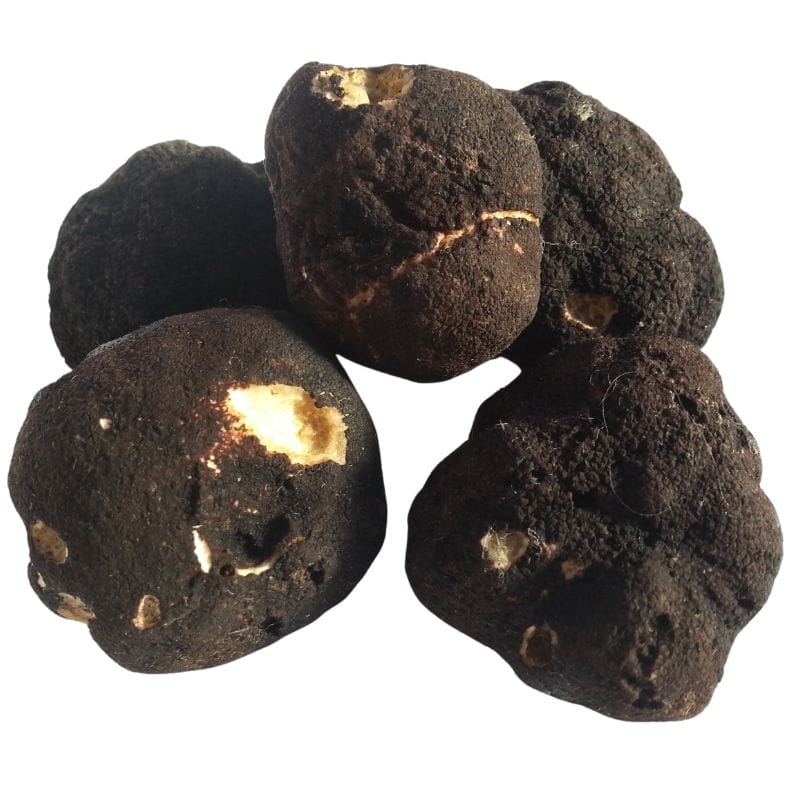
Leucangium carthusianum, also called the Oregon black truffle, grows in the Pacific Northwest and usually shows up around Douglas-fir trees. It’s a native species and one of the more well-known edible truffles from the region.
On the outside, it looks like a small lump of coal—dark black, kind of lumpy or warty, and sometimes slightly smoother in spots. They’re usually about the size of a golf ball, but they can be smaller or larger depending on the season.
Inside, the truffle is firm with a marbled pattern of gray and white veins running through it. When it’s fresh, it smells fruity, almost like pineapple, but the scent gets stronger and muskier as it ripens.
If you’re out looking for them, check in moist, shady forests with soft, loamy soil, especially where there’s a lot of moss or ferns. They grow just below the surface, so people often use trained dogs to help sniff out the ripe ones.
Compared to the Oregon white truffle, which is lighter in color and has a sharper, garlicky aroma, the black truffle has a deeper, more earthy smell. It’s also bigger and firmer than the southern U.S. truffles like Tuber lyonii, which tend to be smaller, paler, and grow around hardwoods like oaks and hickories.
Oregon Winter White Truffles (Tuber oregonense and Tuber gibbosum)
Oregon has two native white truffles that are starting to get more attention: the Oregon Winter White Truffle (Tuber oregonense) and the Oregon Spring White Truffle (Tuber gibbosum). They grow underground in forests and are prized for their strong, savory aroma.
From the outside, these truffles are small, roundish, and kind of bumpy, usually pale beige to light brown. Cut one open, and you’ll see a white interior that darkens with age, showing off a web of white veins when it’s fully mature.
The Winter White Truffle pops up from late fall into February, while the Spring White starts showing up around January and can last into June. They’re pretty similar, but the Winter variety is known for having a more powerful scent and flavor.
To find them, you’ll want to look in forests with younger Douglas-fir trees on the west side of the Cascades. Truffle hunters often check for loose soil or spots where animals have been scratching, which can be a sign there’s something below.
When fully ripe, both types give off a bold smell that’s often compared to garlic, cheese, or earthy spices. They’re usually served raw, shaved over dishes to add that truffle kick without losing any of the aroma.
Appalachian Truffle (Tuber canaliculatum)
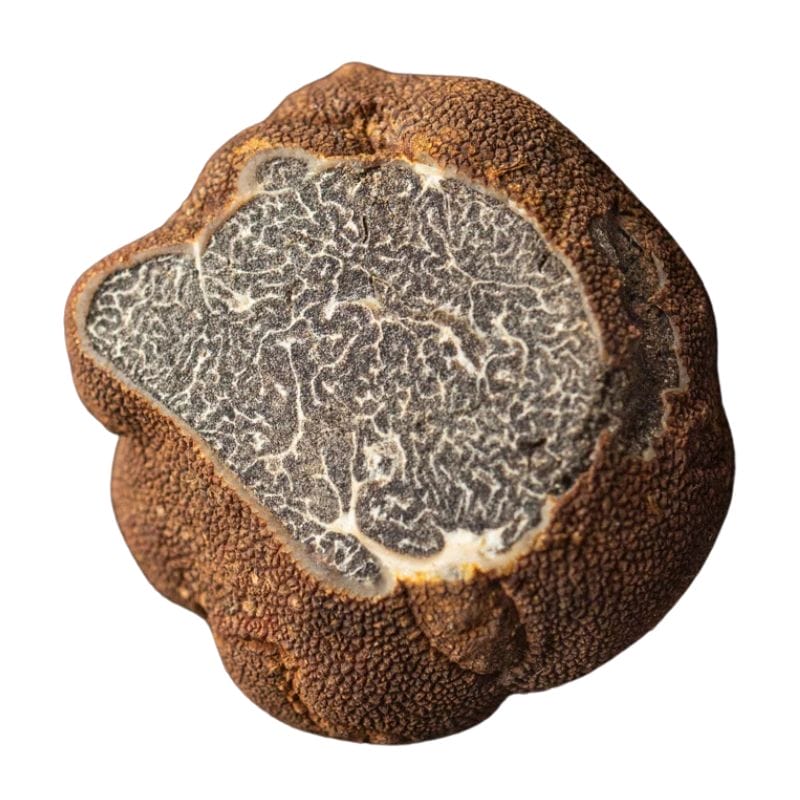
The Appalachian truffle, also known as Tuber canaliculatum, is a native North American truffle that’s slowly getting noticed. It’s about the size of a walnut and has a reddish-brown, bumpy outer surface that looks kind of like a rough, warty potato.
When you cut it open, the inside is firm and dark brown with thin white veins running through it like a marbled pattern. If it’s fully ripe, the smell is strong and earthy—some say it has a kind of nutty, funky aroma that stands out.
You can find these truffles in mixed hardwood forests, especially around oaks and pines, from late summer through fall. They grow underground, so look for spots where the soil is loose and animals like squirrels have been digging—sometimes that’s a good clue.
If you’re foraging, gently raking the top layer of soil near tree roots can help, but a trained dog or even a good nose makes it way easier. Once you know what to look for, the reddish color and bumpy skin are good signs you’ve found the right thing.
Compared to truffles like Tuber oregonense or Leucangium carthusianum, Tuber canaliculatum is more subtle in every way. Its smaller size and lighter scent mean you have to pay closer attention when foraging.
It’s also not as popular in the culinary world because it doesn’t pack the same punch in terms of flavor or aroma. Still, finding one can be rewarding, especially if you’re exploring different types of fungi in the area.
Desert Truffle (Terfezia and Tirmania spp.)
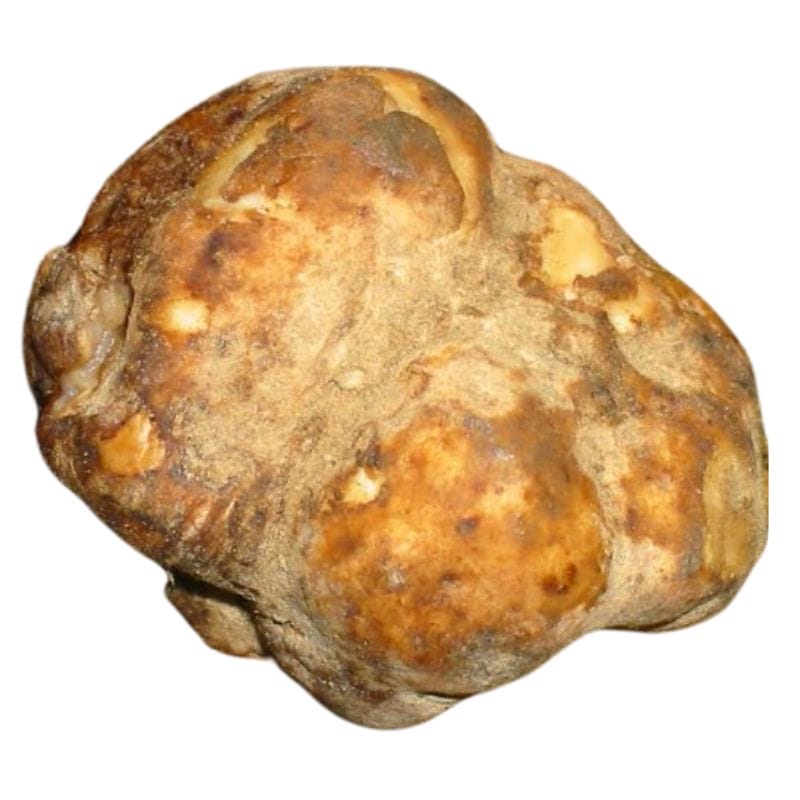
Terfezia and Tirmania are two types of truffles that are sometimes called desert truffles. These are a bit different from the truffles we usually think of, with their bold flavors and rich aromas.
These ones are a little more understated, but they’re fascinating in their own right. What makes them stand out is their ability to thrive in dry, harsh environments where you wouldn’t expect something so delicate to grow.
Unlike the earthy, intense aroma of black or white truffles, Terfezia and Tirmania truffles have a milder scent and flavor. They’re often described as nutty, with a hint of sweetness, but they lack the strong garlicky or musky notes you might associate with other truffles.
Their texture is also different—more firm and less oily than what you’d find with species like Tuber oregonense. They might not have the same culinary punch, but they’re still prized in traditional dishes, where their subtle flavors shine in simpler recipes.
When it comes to appearance, they’re easy to spot once you know what you’re looking for. They’re round to slightly irregular in shape, and their color can range from light beige to a reddish-brown, depending on the species.
The surface is usually smooth or slightly textured, without the rough, knobby look of a black truffle. Cut one open, and you’ll see a pale interior that’s often uniform in color, lacking the intricate veining you’d see in something like Leucangium carthusianum.
Pecan Truffle (Tuber lyonii)
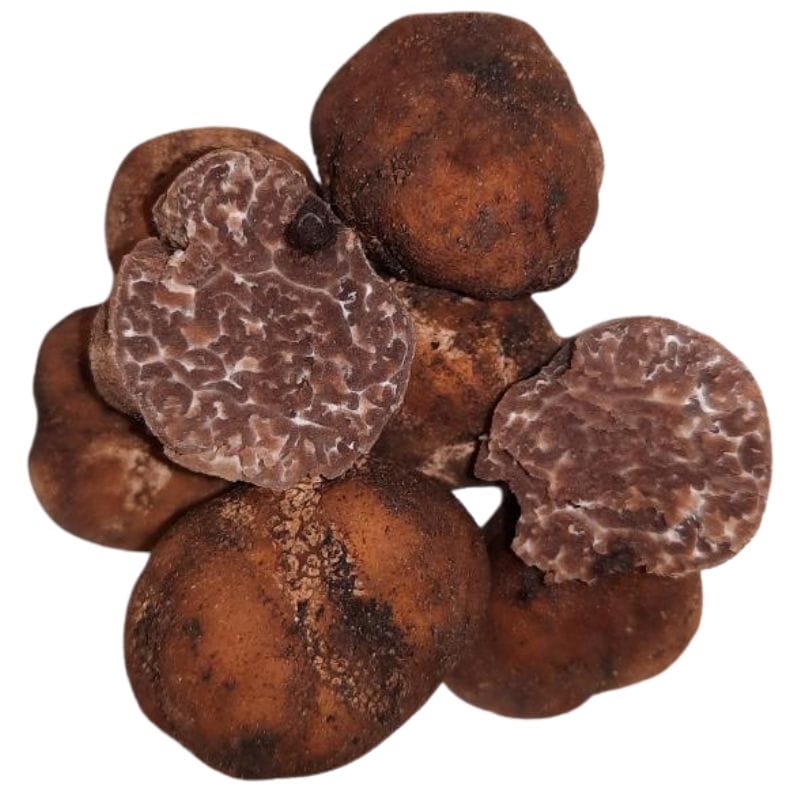
Tuber lyonii, also known as the pecan truffle, is a native North American truffle that grows underground near the roots of pecan trees. You’ll mostly find it in the southeastern U.S., especially in states like Texas, Georgia, and Mississippi.
On the outside, pecan truffles are round to lumpy and have a smooth, light brown skin that darkens as they age. They’re usually about the size of a marble or golf ball, and sometimes they even poke up slightly through the soil surface.
If you slice one open, the inside has a pretty marbled look—light tan streaks mixed with darker brown, almost like wood grain. The smell is earthy, nutty, and kind of warm, especially when they’re fully mature.
When you’re out looking for them, check under mature pecan trees or other hardwoods like oaks and hickories. Trained dogs can help sniff them out, but people sometimes spot them by looking for little cracks in the soil or raised areas near the tree’s base.
Compared to other U.S. truffles like the Oregon white truffle or the Appalachian black truffle, pecan truffles have a milder flavor and are more common in orchards. They’re a solid option in the kitchen—freshly sliced over pasta or mixed into butter—and they don’t come with the high price tag of their European cousins.
Truffle Lookalikes To Avoid
When you’re out hunting you also need to know about a few different fungi species that look very similar to the delicious truffles we’re after but are either inedible or not worth eating. Keep an eye out for:
Pine Truffles (Geopora cooperi)

Geopora cooperi is a fungus that can easily confuse someone new to truffle hunting. It’s sometimes called the pine truffle because it grows underground like a true truffle and often pops up near certain trees.
At first glance, it might seem like you’ve hit the jackpot, but this one is a false truffle, not something you’d want to eat or sell.
The easiest way to tell Geopora cooperi apart from real truffles is by looking closely at its structure. While true truffles have a smooth or slightly knobby exterior and a marbled interior, Geopora cooperi has a rougher, more irregular outer surface.
When it matures, it sometimes splits open, revealing a cup-like shape, which true truffles never do. Inside, it’s less dense and doesn’t have the intricate veining that makes real truffles so unique.
Another big difference is the smell. True truffles have a strong, rich aroma that’s earthy, sweet, or garlicky, depending on the species. Geopora cooperi, on the other hand, has a much weaker scent, and it’s not as pleasant or distinctive.
If you’re relying on aroma to identify your find, this one will give itself away pretty quickly. So, while it might look similar at first, a closer inspection will show it’s not the culinary treasure you’re hoping for.
Stinking Slime Truffle (Melanogaster ambiguus)
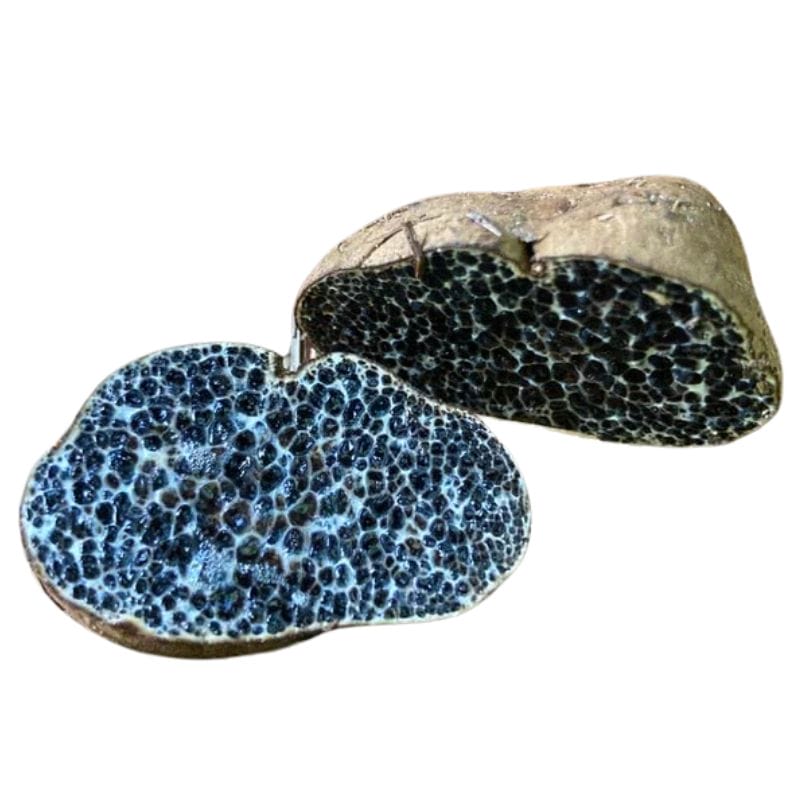
Melanogaster Ambiguus, because of their reddish-brown to dark brown exterior, might look like true truffles at first glance, but they’re quite different when you know what to look for.
The key difference is on the inside. When you cut open Melanogaster ambiguus, the interior is filled with flattened cells that have a shiny black gelatinous feel to them. Real truffles, on the other hand, have those beautiful marbled veins running through their flesh, almost like a web.
Another giveaway is the smell. While real truffles have a rich, earthy aroma that’s mouthwatering, Melanogaster ambiguus tends to have a much stronger, almost unpleasant odor—it’s not something you’d want to sprinkle on your pasta.
Earthballs (Scleroderma)
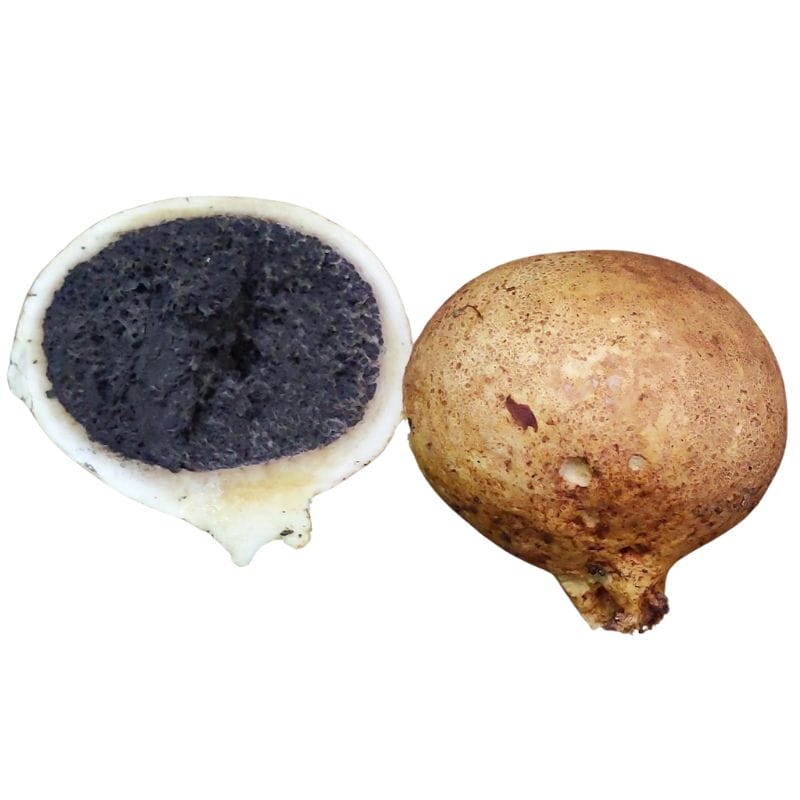
Scleroderma, commonly called earthballs, can easily fool someone who’s just starting out because they grow underground and have a round shape similar to truffles. But don’t be tricked—Scleroderma is not a true truffle, and it’s actually toxic, so it’s important to know how to tell the difference.
The first thing you’ll notice is the outer skin, which is thicker and tougher than that of most truffles. It can range in color from yellowish to dark brown, often with a rough or cracked texture.
If you cut it open, the difference becomes even clearer. While true truffles have a marbled interior with delicate white veins, Scleroderma starts out with a whitish inside that quickly darkens as it matures, turning black or purple with no marbling. It’s dense and solid, almost like charcoal in the later stages.
Another big giveaway is the smell. True truffles have a rich, earthy aroma that makes them so prized, while Scleroderma has little to no pleasant scent—some even describe it as musty or unpleasant.
Deer Truffles (Elaphomyces)
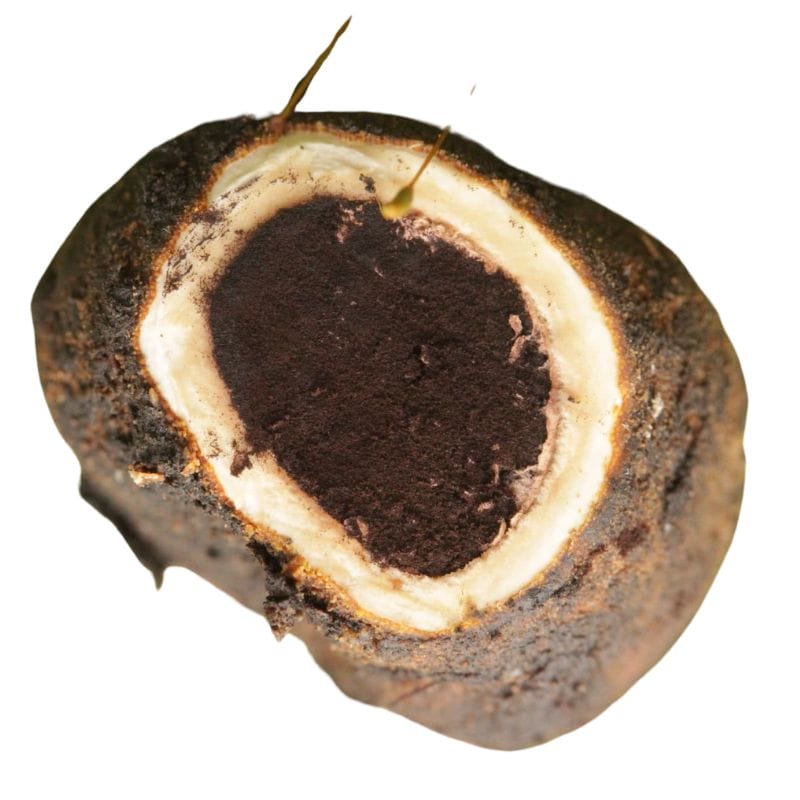
Elaphomyces, also known as deer truffles, look like true truffles at first glance, but they’re a whole different story. They’re called deer truffles because wildlife, especially deer and rodents, love to eat them. For us humans, though, they’re not edible—and definitely not what you want to mistake for a prized truffle.
Here’s how you can tell Elaphomyces apart from the real thing. First, they have a tough, warty outer surface that can range from pale tan to black, depending on the species and their age.
When you cut them open, the inside is solid and sometimes speckled or marbled, but not in the delicate, vein-like pattern you’d see in true truffles.
Their smell is also a big giveaway. Instead of the rich, earthy aroma of an edible truffle, Elaphomyces either has little scent or an odor that’s earthy but not particularly appealing.
Another thing to know is that Elaphomyces often grows deeper in the soil than true truffles, and they tend to have a harder, woodier texture.
Best Practices For Finding Truffles
Truffle hunting can be a rewarding adventure if you know the right tips and tricks. Here’s what you should keep in mind to improve your chances of finding these underground treasures:
Wait 10 to 14 Days After Heavy Rain
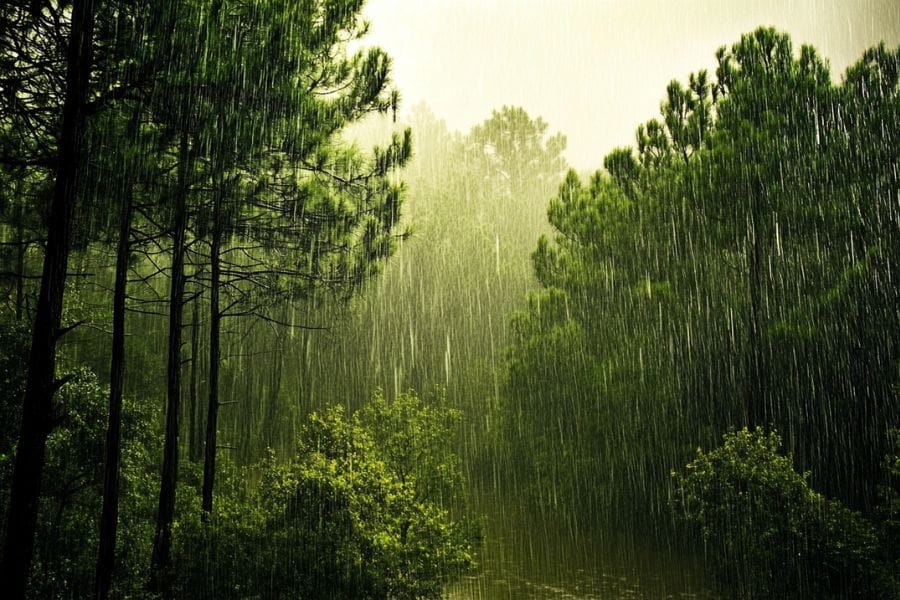
After a heavy rain, it’s best to wait about 10 to 14 days before heading out. This gives the truffles time to mature and release their signature aroma, making it easier for you (and your dog) to sniff them out. Rain helps truffles grow, but they don’t start giving off their scent right away.
As the soil warms up, the truffles get more aromatic, and the ground becomes looser, which makes digging easier without disturbing the environment too much. The timing is perfect to find truffles at their best—both in quality and in how easy they are to locate.
Find the Right Trees
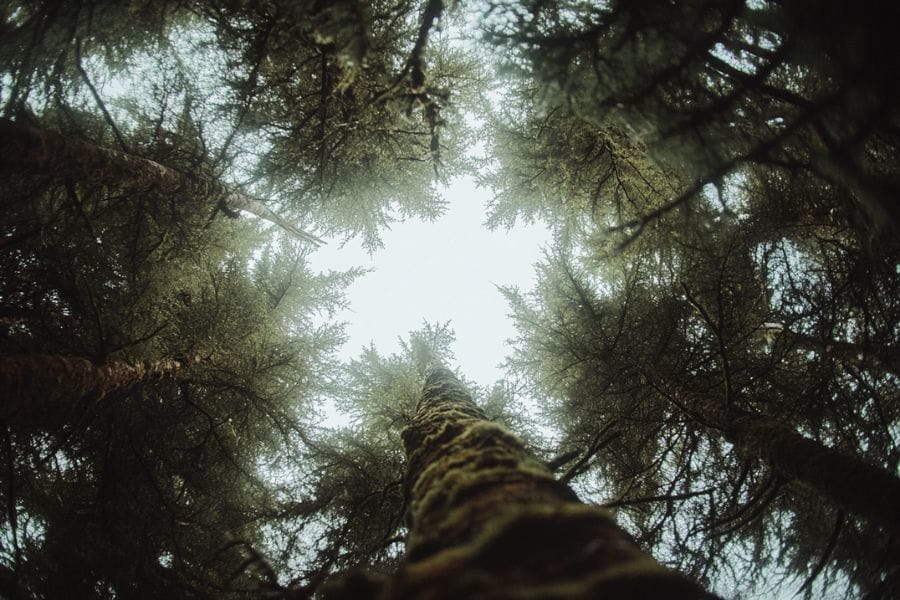
Truffles don’t grow just anywhere—they have a special relationship with certain trees. You won’t find them under just any tree, so knowing which ones to look for can make all the difference. Some of the best trees to look out for are:
- Pines
- Douglas-firs
- Oaks
- Hazelnuts
- Cypresses
- Willows
For example, if you’re looking for Oregon white truffles, keep an eye out for Douglas-fir trees. California black truffles, on the other hand, are often found near oaks and hazelnuts. The soil around these trees also needs to be slightly alkaline, so it helps to know what kind of ground you’re walking on as well.
Watch for Wildlife Activity
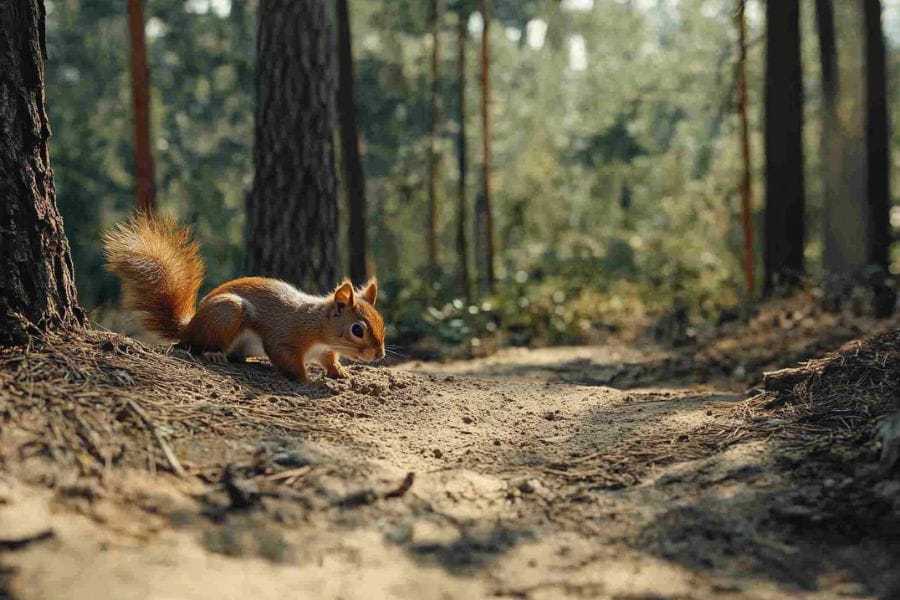
Animals like squirrels and chipmunks often help spread truffle spores, and sometimes their digging can lead you straight to truffles. While you won’t always find truffles in every pit animals dig (they also look for things like acorns or bulbs), fresh digs are a good clue. The more recent the pit, the better chance it has of leading to truffles.
Even though animals are a part of the truffle cycle, most hunters prefer using dogs to find the real treasure underground. Dogs have an incredible nose for truffles and can pinpoint their location much more reliably than any squirrel or chipmunk.
Get a Little Help from a Truffle-Hunting Dog
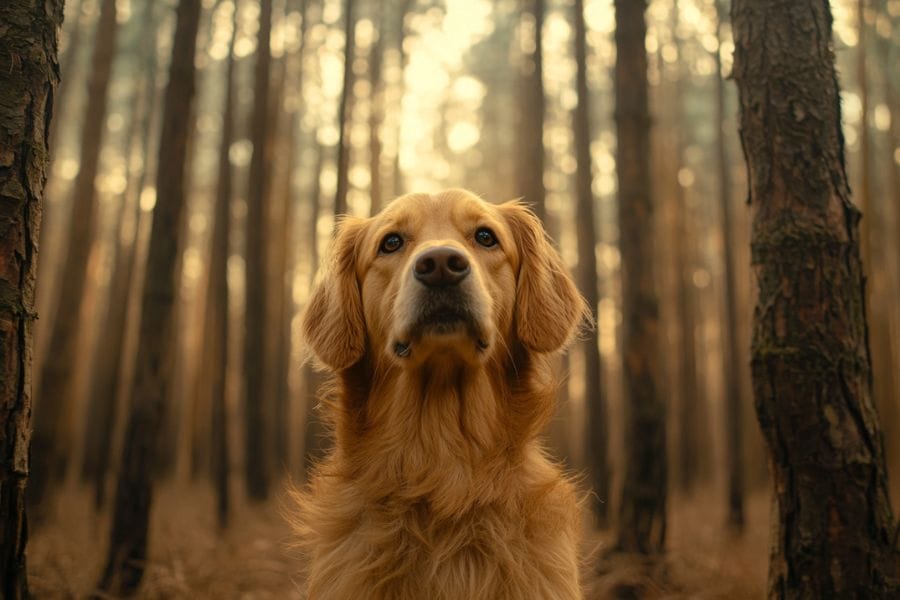
If you’re serious about truffle hunting, a trained dog can make your life a whole lot easier. Their sense of smell is extraordinary, and they’re trained to find mature truffles buried beneath the surface. Many truffle hunters swear by their dogs, and for good reason—they’re much more accurate than humans when it comes to sniffing out truffles.
If you don’t already have a trained dog, you can connect with local foraging groups or specialized trainers who offer truffle-hunting services. Some places even host events where you can see experienced handlers with their dogs in action. And if you’re feeling adventurous, you can train your own dog using truffle-scent kits and practice in a controlled space before hitting the woods.
Before you head out
Before embarking on any foraging activities, it is essential to understand and follow local laws and guidelines. Always confirm that you have permission to access any land and obtain permission from landowners if you are foraging on private property. Trespassing or foraging without permission is illegal and disrespectful.
For public lands, familiarize yourself with the foraging regulations, as some areas may restrict or prohibit the collection of mushrooms or other wild foods. These regulations and laws are frequently changing so always verify them before heading out to hunt. What we have listed below may be out of date and inaccurate as a result.
Where You Can Find Truffles Around The State
Now we’re going to go over five of the best locations for finding truffles. We’ll go a bit in-depth here and then provide a much longer list of other spots to try.
Clinton State Park
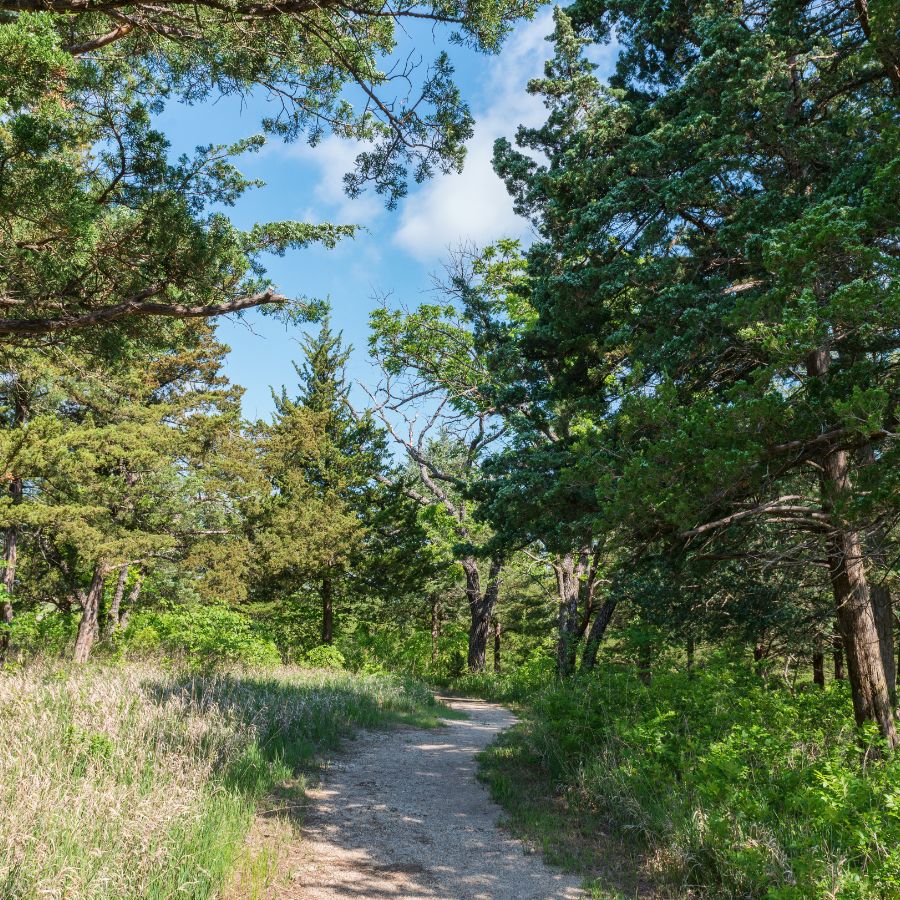
Clinton State Park sits near Lawrence, covering 1,500 acres of beautiful woodland around Clinton Lake. The mix of oak, hickory, and walnut trees creates perfect conditions for truffles to grow. Many people come here to camp and hike without knowing about the hidden truffle treasures.
Look for truffles in the mature oak groves on the north side. The slightly acidic soil from years of leaf litter makes truffles happy. Search near the bases of older oak trees where the ground isn’t too hard.
Early mornings are best because the forest floor is still moist. This makes it easier to spot little bumps in the soil that might be truffles. Bring a small rake to gently move the top layer without causing damage. The park rangers are friendly and sometimes know where others have found truffles before.
Mined Land Wildlife Area
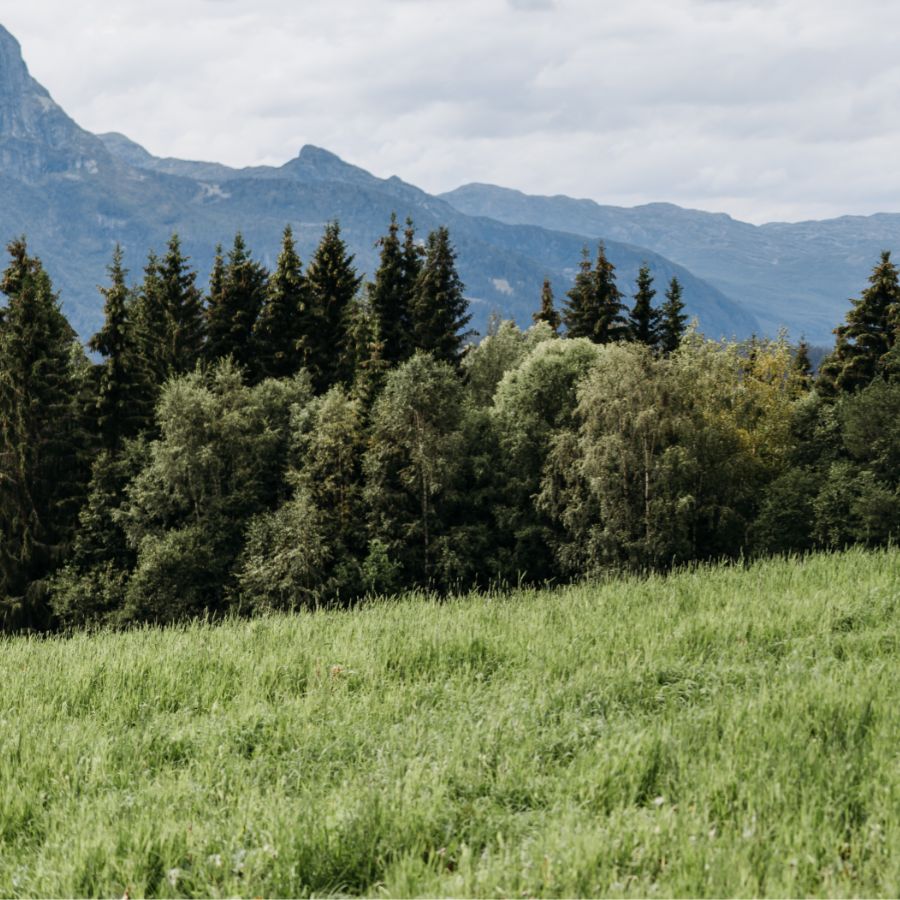
Mined Land Wildlife Area is a unique 14,500-acre area in southeast Kansas created from old coal mining operations. The landscape is dotted with over 1,000 water-filled pits and unusual terrain that creates microenvironments perfect for truffle growth. This reclaimed land has developed into diverse habitats since mining stopped.
The eastern section with mature trees growing on reclaimed soil is best for truffle hunting. The disturbed ground has created unusual soil conditions where certain truffle species thrive. Years of leaf litter from new growth forests has enriched the soil.
Look around oak and pine trees that were planted during reclamation efforts. The combination of mineral-rich soil and these trees creates perfect conditions for mycorrhizal relationships. Many hunters have succes in areas where the ground has slight depressions that hold moisture after rain.
Big Hill Wildlife Area
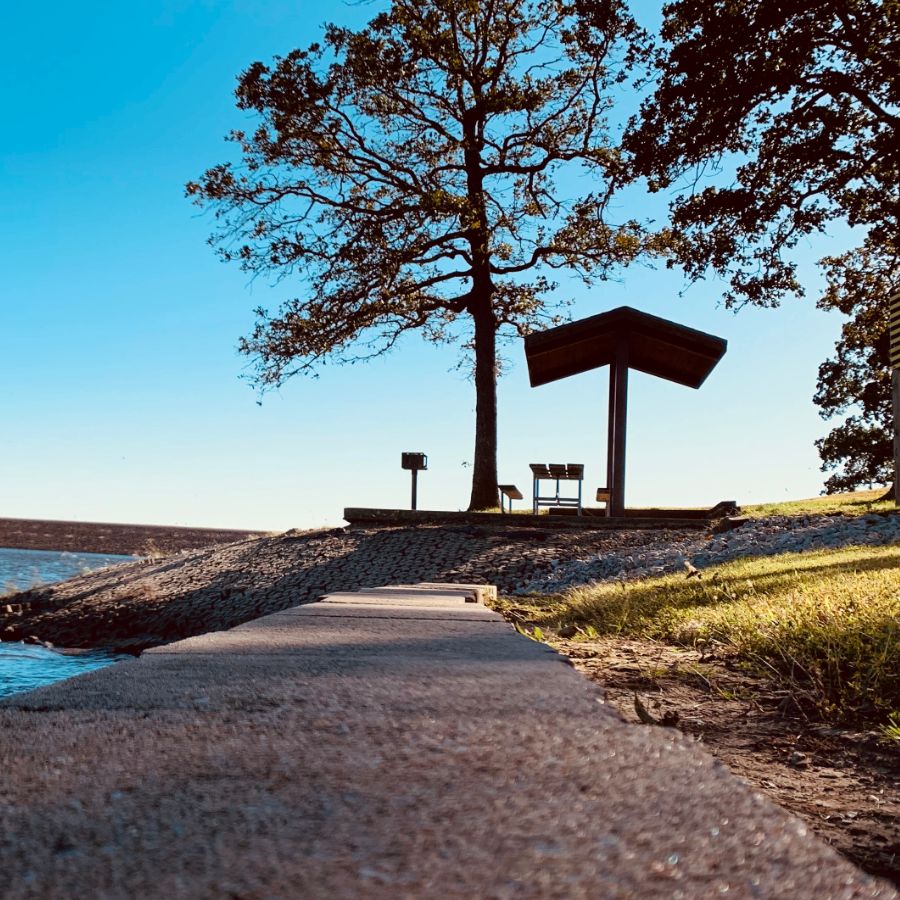
Big Hill Wildlife Area spans 11,000 acres around Big Hill Reservoir in southeastern Kansas. The area features a mix of oak-hickory forests, old fields, and wooded draws that create diverse habitats for wildlife and fungi. The varied landscape makes it a hidden gem for truffle enthusiasts.
Truffle hunters should focus on the mature oak forests on the area’s western side. These established woodlands have the right combination of tree species, soil pH, and moisture retention for truffles. The area gets less foot traffic than state parks.
The soil here has a unique composition due to the watershed that feeds the reservoir. This creates special conditions where certain truffle varieties flourish. Check around fallen logs and in areas with thick leaf litter where the ground hasn’t been disturbed for years.
The best spots are often in the transition zones between forest and meadow where moisture levels are just right for truffle development.
Fall River State Park
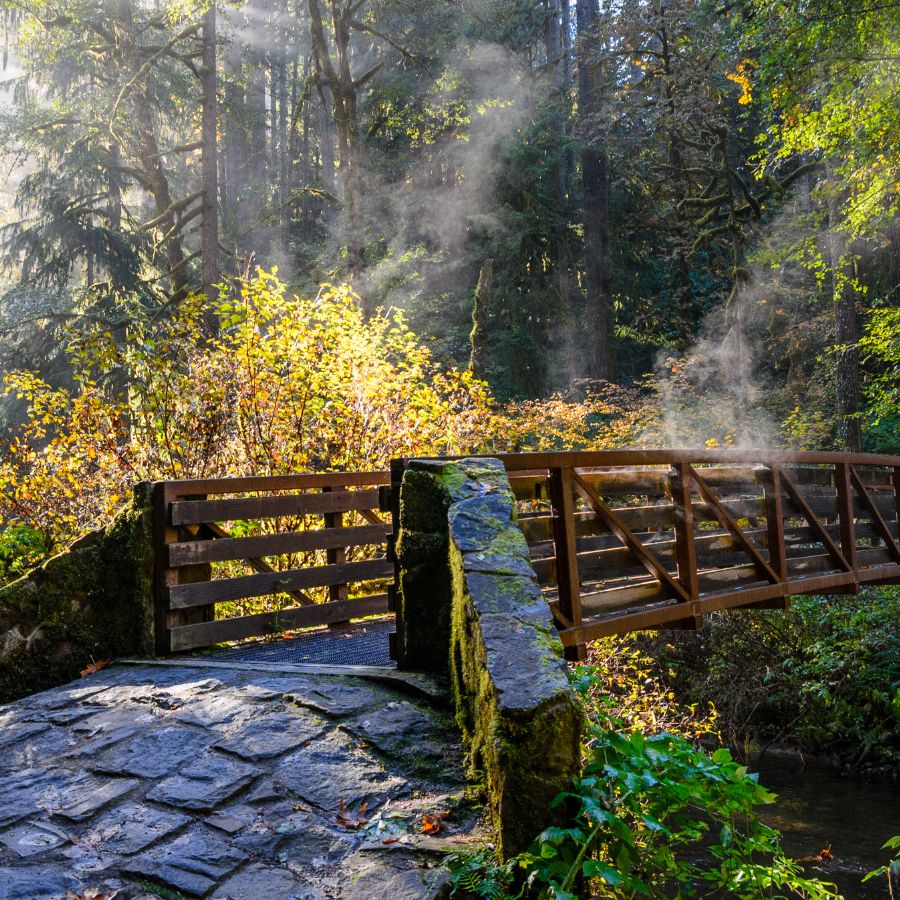
Fall River State Park covers 980 acres in the southeastern Flint Hills. Its mix of woodlands, prairies, and riverside areas creates many places for different truffle types to grow. The park’s hills and valleys provide various soil conditions and moisture levels.
The western part of the park has mixed hardwood forests that truffles love. Search near hickory, oak, and elm trees, especially in slightly sunken areas that hold moisture.
Many experienced hunters look near the Quarry Trail after warm rains. The tree canopy here creates perfect shade and moisture for truffles to grow. The eastern sections have limestone that makes the soil more alkaline, which some truffle species prefer. Since the park is somewhat remote, you won’t find many other people looking for truffles.
Cross Timbers State Park
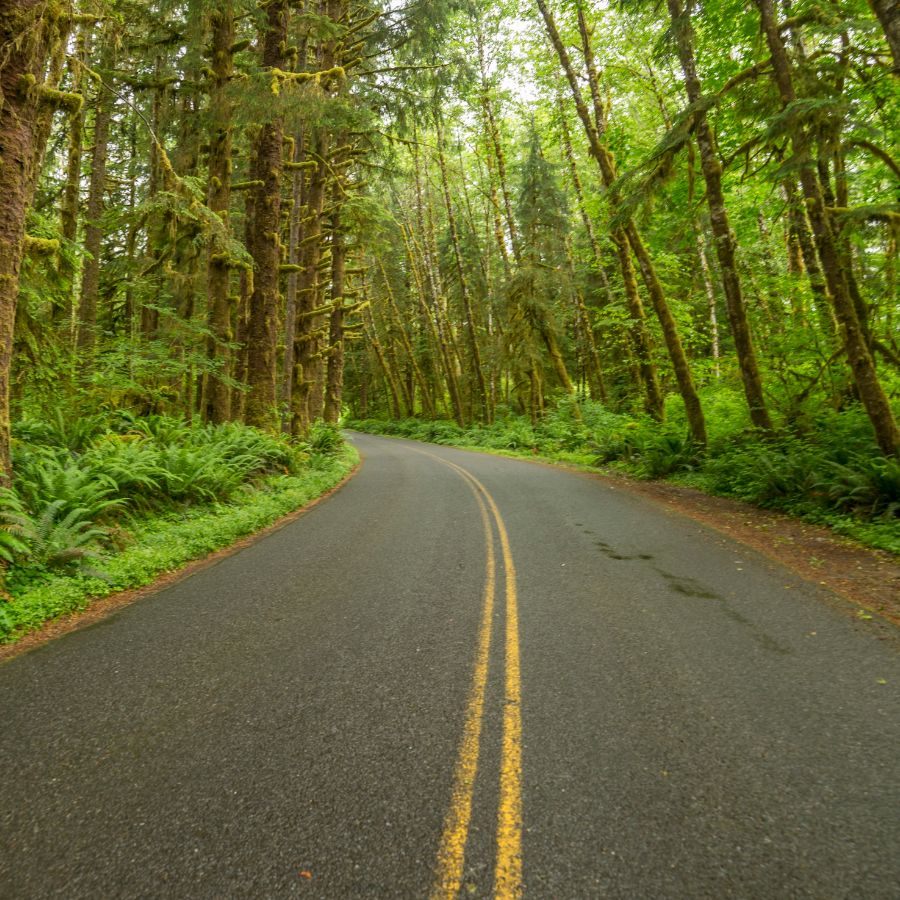
Cross Timbers State Park sits at the edge of the Flint Hills near Toronto Lake. It’s named for its unique ecosystem that mixes forest, savanna, and prairie. Some post oak trees here are 200 to 400 years old.
The Ancient Trees Trail offers the best truffle hunting opportunities. These old-growth forests have established root systems that have developed relationships with truffle fungi over decades. Years of fallen leaves have created rich soil where truffles thrive.
This park has distinctive red clay soils unlike other Kansas parks. These support different truffle species. Look for small mounds near the bases of mature oaks and hickories. Areas with moderate slopes that get morning sun but afternoon shade maintain perfect moisture for truffles to grow.
Other Great Locations For Truffles
Northeast Kansas
| Location | Collection Guidelines |
|---|---|
| Banner Creek Reservoir | Hand collection of wild mushrooms, including truffles, is generally allowed in non-restricted zones. |
| Clinton State Park | Truffle foraging is allowed on hiking trails and wooded edges, away from camping and recreational zones. |
| Kaw River State Park | Small-scale foraging for mushrooms is permitted in natural areas along trails. |
| Perry Wildlife Area | Foraging is allowed with foot access only; avoid agricultural plots. |
| Prairie Center Wildlife Area | Visitors may collect wild mushrooms in wooded and shaded areas. |
| Tuttle Creek State Park | Allowed in forested sections; avoid marked conservation study areas. |
| Weston Bend State Park (KS side access) | Mushrooms may be collected along upland forest trails. |
Southeast Kansas
| Location | Collection Guidelines |
|---|---|
| Big Hill Lake Area | Limited mushroom gathering allowed near wooded trail sections. |
| Cross Timbers State Park | Foraging is permitted in mature hardwood zones under canopy. |
| Fall River State Park | Truffles may be found near oak-hickory areas and foraged responsibly. |
| Flint Hills Trail State Park (Eastern Segment) | Collection allowed along shaded woodland margins. |
| Montgomery State Fishing Lake | Mushroom foraging permitted near forested fishing trails. |
| Toronto Wildlife Area | Truffle foraging allowed in natural forest cover, away from waterfowl zones. |
| Woodson State Fishing Lake | Allowed in non-restricted wooded and brushy areas. |
South Central Kansas
| Location | Collection Guidelines |
|---|---|
| Cheney Wildlife Area | Wild mushroom collection allowed in timber stands; foot access only. |
| Cowley State Fishing Lake | Foraging permitted in wooded areas not designated for game hunting. |
| El Dorado State Park | Truffle hunting allowed near trails and undeveloped woodland. |
| Fall River Wildlife Area | Collection allowed in riparian zones and shaded woodland margins. |
| Sand Hills State Park | Wild mushroom foraging permitted in forested sections. |
North Central Kansas
| Location | Collection Guidelines |
|---|---|
| Glen Elder State Park | Allowed in native woodlands and shaded soil patches. |
| Kanopolis State Park | Mushroom collection allowed on forest floor near stream valleys. |
| Milford State Park | Foraging permitted in undeveloped sections near tree lines. |
| Ottawa State Fishing Lake | Allowed in areas with tree cover, especially near trail loops. |
Northwest Kansas
| Location | Collection Guidelines |
|---|---|
| Cedar Bluff State Park | Foraging permitted in woodland pockets and shaded bluffs. |
| Prairie Dog State Park | Mushroom gathering allowed along wooded trails. |
Southwest Kansas
| Location | Collection Guidelines |
|---|---|
| Clark State Fishing Lake | Allowed in forest patches and shaded soil areas. |
| Meade State Park | Wild mushroom collection allowed near shaded stream corridors. |
| Sandsage Bison Range and Wildlife Area | Foraging allowed in wooded pockets; not in bison range. |
| Scott State Park | Collection permitted along wooded trails and canyon areas. |
Central Kansas
| Location | Collection Guidelines |
|---|---|
| Maxwell Wildlife Refuge | Small-scale mushroom foraging allowed in forested habitat zones. |
| Quivira National Wildlife Refuge | Truffle foraging is allowed in public-use woodland access zones. |
| Wilson State Park | Permitted near tree-lined trails and shaded limestone outcrops. |
When The Best Time Of The Year Is To Find Truffles
In Kansas, truffle hunting season runs from late spring through early fall, with peak finds happening between May and September. Most Kansas truffles prefer the warmer soil temperatures of summer. The ideal time is about 7-10 days after a good rainfall when the ground has had time to warm up but still holds moisture.
June and July are particularly productive for finding immature truffles, while August yields more mature specimens with stronger flavors. Some varieties, like the pecan truffle, appear later, around mid-August through October. Morning hunts are best, from 6-10am, when the truffle aroma is strongest in the cool air.
Look for slight cracks or bumps in the soil surface. Many Kansas hunters say the days following a thunderstorm with tempratures between 75-85°F create ideal harvesting conditions. Local truffle enthusiasts report the best finds come after several days of consistent humidity.
One Final Disclaimer
The information provided in this article is for general informational and educational purposes only. Foraging for wild plants and mushrooms involves inherent risks. Some wild plants and mushrooms are toxic and can be easily mistaken for edible varieties.
Before ingesting anything, it should be identified with 100% certainty as edible by someone qualified and experienced in mushroom and plant identification, such as a professional mycologist or an expert forager. Misidentification can lead to serious illness or death.
All mushrooms and plants have the potential to cause severe adverse reactions in certain individuals, even death. If you are consuming foraged items, it is crucial to cook them thoroughly and properly and only eat a small portion to test for personal tolerance. Some people may have allergies or sensitivities to specific mushrooms and plants, even if they are considered safe for others.
Foraged items should always be fully cooked with proper instructions to ensure they are safe to eat. Many wild mushrooms and plants contain toxins and compounds that can be harmful if ingested.

